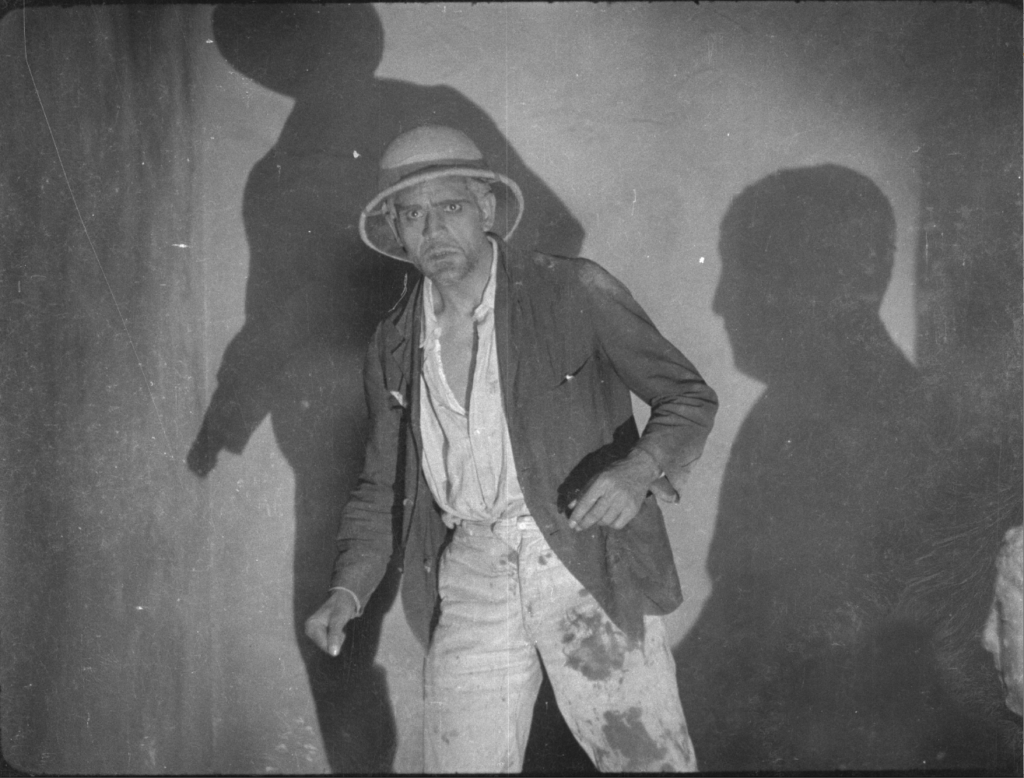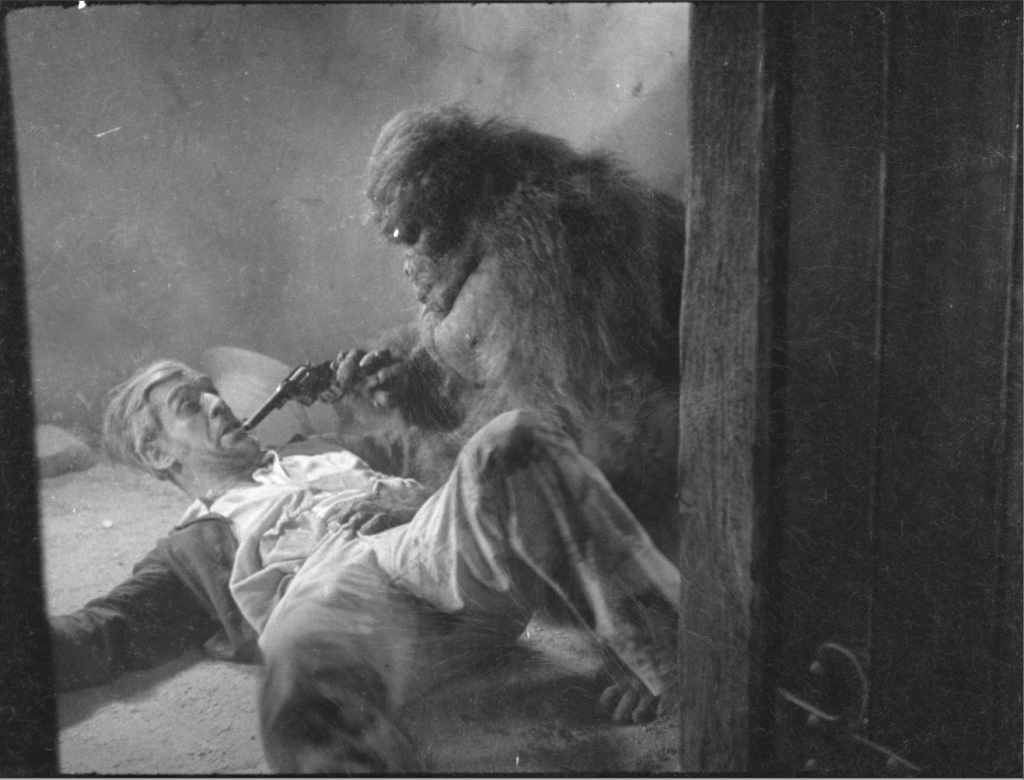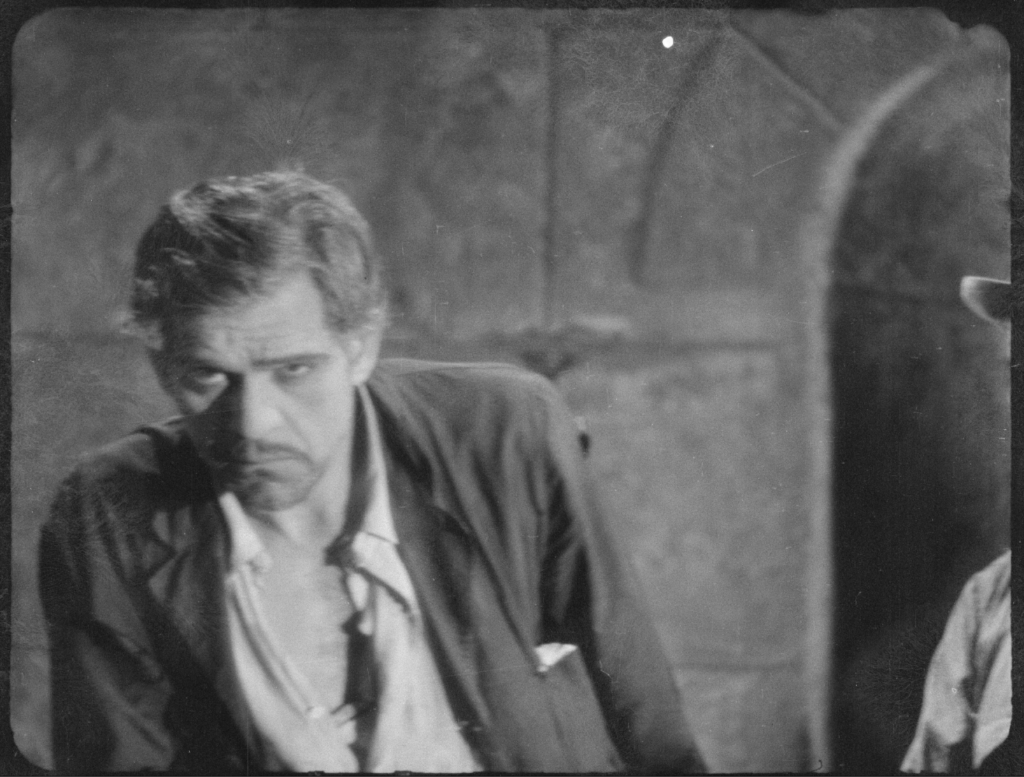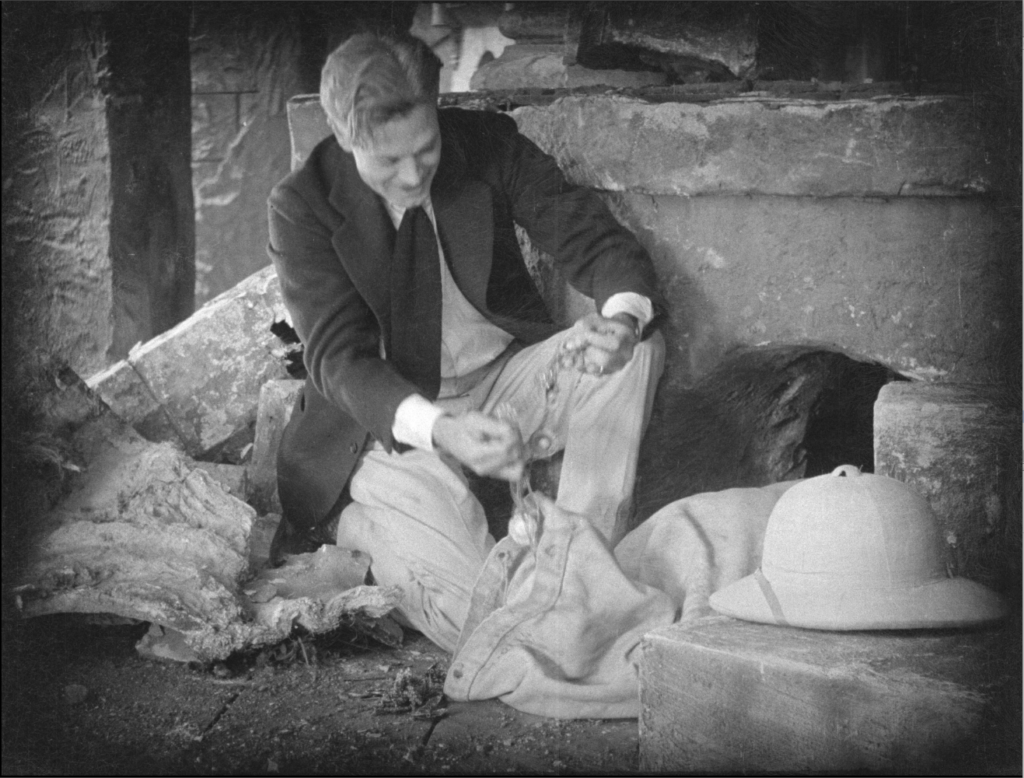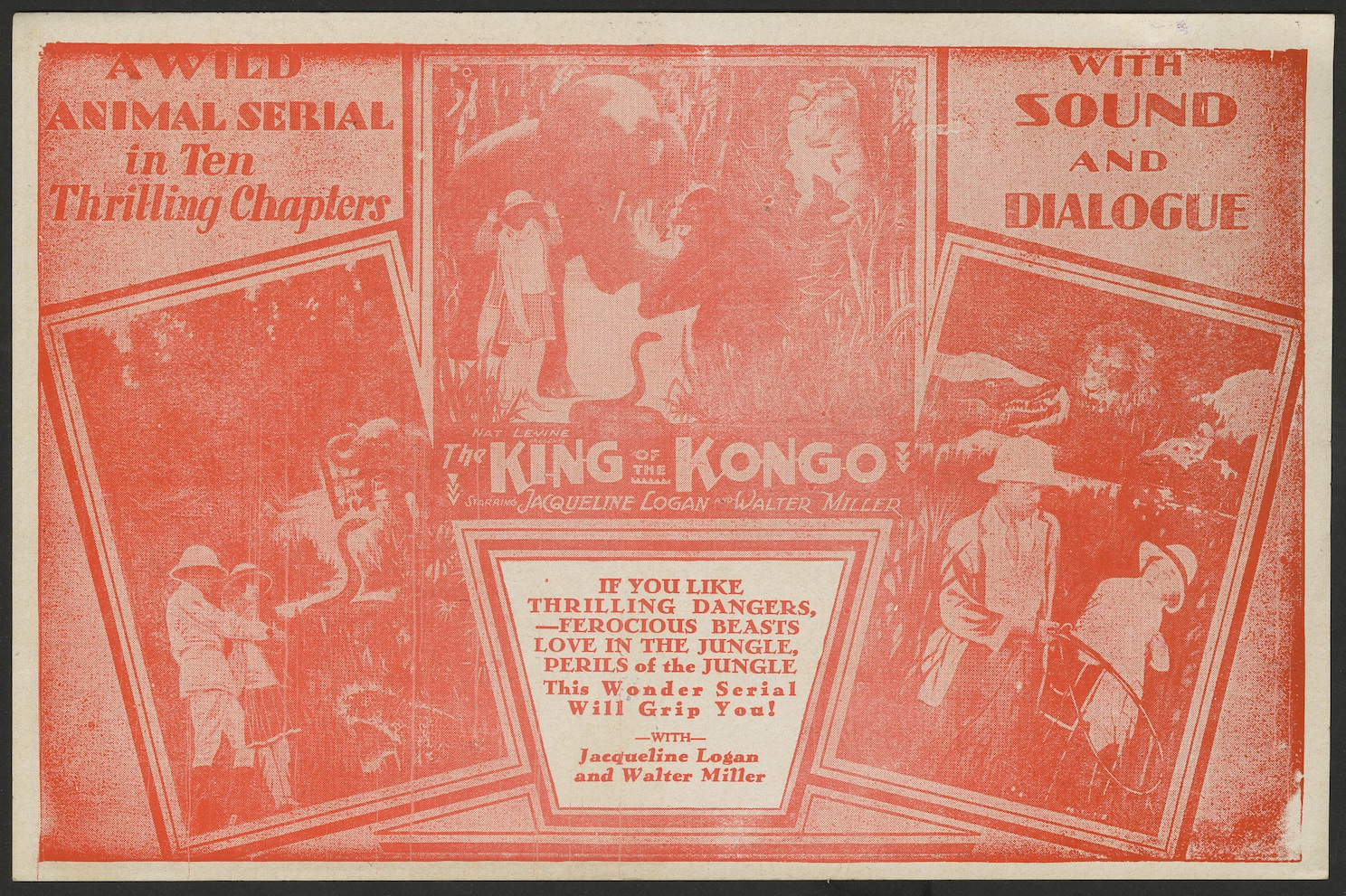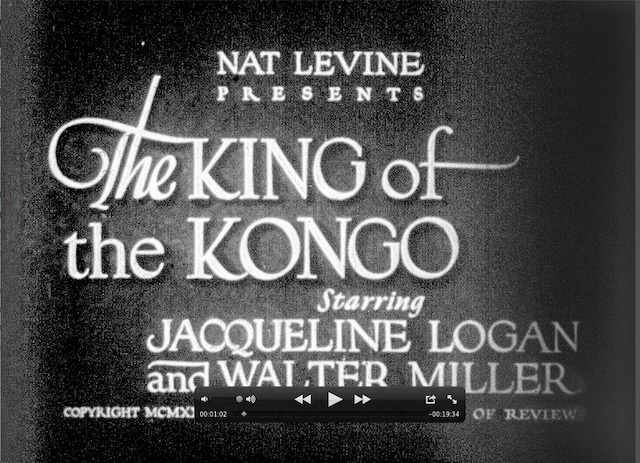Some of you are asking what’s taking King of the Kongo so long. Let me describe to you why in three words: it’s a mess. The more I get into it, the uglier and messier it gets. I know many of you don’t want to hear about this because you consider it whining, and I’ll hear about it. I know many of you like to hear what’s going on, and I’ll hear about that too.
Let me answer the questions I keep getting:
1. Are you actually still working on Kongo?
Yes, almost nothing else. It’s taking forever. You’ll see why in a bit.
2. We’re all getting older. Are you going to release it?
Yes, I’m hoping by the end of the year. At the pace we’re going, that may be optimistic. Remember that this is 21 reels of footage whereas Little Orphant Annie was FIVE reels of footage. And Annie was in better shape.
3. Why don’t you do a Kickstarter to get some extra funds to hire some help?
That’s a fantastic idea. Right now, I’m stretched pretty thin doing all the stuff I’m supposed to be doing. Doing a Kickstarter takes time and effort that I don’t have to put into this. Someone wanna volunteer? (Crickets.) I didn’t think so.
4. Didn’t you get a grant to work on this? Use some of that money.
Yes, I got a grant to do it, and I discovered in May of 2020 that I needed two things: a) a faster computer or I’d never get it done, and b) at least two more helpers to help me get things done. I’ve done those things. I have three helpers now. But the grant money only covered the cost of the computers.
Here’s what I’ve been doing:
I suspended work on Chapter 10 given some priorities. I announced in December of last year that I’d be showing some rare Karloff stuff and we’d have Sara Karloff join us for a Zoom meeting. I thought if I held it in March that FOR SURE we’d have enough to show. Chapter 10 resolves all the hanging plot points: Who or what is the gorilla (aka the King of the Kongo)? Who’s the girl’s father? Where are the jewels? Who’s the prisoner in the basement? I thought that using Chapter 10 as my example was kind of a bad idea.
Given this, I thought maybe I’d try getting Chapter 9 done, since we’d gotten a good start on it. But we had problems: my helper was bogged down in the cleanup, and there was a great deal of decomposition on the negative. I finally told him that we’d get rid of the decomp later; just go for the dirt. That didn’t help. He was making no progress.
I finally figured out why. The decomp really didn’t seem too bad until you got into it and then it was triggering all sorts of false positives in the cleanup software. I had a backup plan: unlike Reel 1, we had a print for Reel 2 as well. We could just use that instead of using the negative. The print was in reasonably good shape with not too much decomp.
WRONG. The print was missing shots all over the place. It had been sliced apart for stock footage and then put back together with masking tape. Each time they sliced it apart, they put it back missing a frame on both edges. But that was OK, since two or three shots were missing entirely. One sequence was in the wrong place. And then the coup: there’s a shot in Chapter 9 reel 2 that belongs in Chapter 10 reel 1! This was nice, because that shot is missing in the print of Chapter 10 that we have (minus one frame on each side of the splice.)
So in late December, after we’d already announced, I took the disks with the negative and the print, and we went through them frame at a time to figure out what had been put where, reconstructing the best shots from the best prints. That then had to be re-stabilized and re-scaled. Great, huh? Turns out not. As we were removing dirt I discovered that something looked weird. We were accidentally cleaning up a low-res test version of this file, not the high-res version that we needed. Late January. Start again.
So maybe let’s get Chapter 8 going? Well, that’s in the hands of another helper I have, and he is going through it. Except Chapter 8 has a particularly ugly dialogue scene in it and it would require a massive amount of re-recording. And we have the sound for R2, which looks to be edited, so that would be a sync problem. We have the negative for R2 but alas, I haven’t received it yet, because the scanning is behind at Library of Congress, so it seemed a real waste of resources to work on this chapter that we were probably going to have to tear out anyway. Plus the sound hasn’t even been started for restoration, so that’s an issue.
Chapter 7 we have, but it’s got a lot of decomp and hasn’t been started.
By this point, in early February, I was about to call Sara and tell her we should cancel the show. I just did not see how we could get anything ready. I’ve got another helper lined up, but he got COVID, and he’s got some other family illness, and he had other commitments.
So I thought, OK, let’s try Chapter 5 and 6. Those don’t look too bad, either! Let’s try those! And we have restored sound for them. Chapter 5 looked promising until I discovered that reel two is the silent version that doesn’t match the sound version at all. The picture for the sound version of Chapter 5 reel two is not scanned yet. Chapter 6 looked more promising. It looked pretty good until I realized that the ending was rotted off in the negative. OK, let’s look at the print. Also rotted off, no cliffhanger. Then I remembered that some of Robert Youngson’s compilation film The Days of Thrills and Laughter features the fight between Karloff and Walter Miller (I’d seen the stills). That’s the cliffhanger I need!
So I wrote Serge, knowing he had some 35mm of this title, and asked him if he could scan it for me. Well, the scanner place is down due to COVID, but sure, he agreed to do it. Just to verify, I found a copy of Days of Thrills and Laughter and looked at it. Turns out that what Serge has is the beginning of Chapter 7, not the end of Chapter 6, with the same fight, but it’s the cliffhanger resolution. Then I went back to Chapter 7 and discovered that the negative for reel one is complete, but the print is missing exactly the footage that’s in The Days of Thrills and Laughter. Yep, it was copped from the same print I have!
OK, so I can insert the cliffhanger ending from the 16mm that I already have scanned and then just go from there? No, bad call, because there’s a SECOND print of Chapter 6 that is in the inventory of stuff not yet scanned at the Library, so no reason to rescale and re-contrast that icky footage when that will just be replaced anyway. And I hope that the print is in better shape than the alternate print we have. Who knows? Maybe it’s the silent one. We have no idea. But given what I’ve seen, I sure want to look at it before investing a lot of time starting a restoration. (Interestingly, Chapter 5 and 6 are tinted, and the tinting is fading from these prints. We intend to restore it.)
For those of you keeping score, Chapter 10 is out, Chapter 9 is questionable, Chapter 8 is probably out, and Chapter 5,6,7 are out. And we don’t have any more complete chapters. This is why you hear me scream. I nearly called Sara again and said we’d have to postpone.
That’s where your heroine, Ms. Greiff, stepped in and told me that we could probably do this. She thought I could lean on my helper working on Chapter 9 and meanwhile I could get reel 2 recorded.
I’d wanted to do the sound recording to the restored print, because it’s easier to see lip sync, etc, but she said we should just synchronize to the negative. After all, the frame count was the same, so it should work. We spend our time recording and my helper does the contrast fixing and de-dirting! It could happen!
Well, for those of you who don’t follow this, each reel is one disk and each chapter is two reels (except Chapter 1, which is three). And we don’t have discs for all the picture. We have Chapter 9, reel one, but not reel two!
Since the music is repetitive—they use the same themes over and over, I thought, gee, we can “fake” the score by using some of the same themes. I know they had sound effects (they particularly liked gunshots), so I found a gunshot and sampled it, then threw one in in sync with every shot. The gorilla theme is consistent throughout: whenever the gorilla is on screen, there’s a sinister violin theme that accompanies him. So we know what that would have sounded like. And the close tag is the same in every chapter, so we know that.
With about a day’s work, I got a serviceable “guess” track going that sounded pretty much like an original track would have. Except we didn’t have the dialogue scene. OK, I have the script, so I just recorded the dialogue and synchronized it to the players.
Meanwhile, my helper is working on the same reel to get the picture cleaned up. This is an agonizing process and takes hours.
The dialogue didn’t synchronize at all. The actors weren’t reading the dialogue as it was written. What were they saying? Who knows? I knew that Peter Jackson had employed forensic lip readers for They Shall Not Grow Old. I watched that (not as amazing as people said, but what do I know?) and contacted the forensic lip-reader. $200 a minute! Not possible.
I contacted the Indiana School for the Deaf. They didn’t get back to me. I contacted two other deaf people. No response. Another one: “This is too hard… you mean you don’t have any sound at all??” Finally, in desperation, I said, “I’ll do this MYSELF.” I slowed it down 4:1 and blew up the lips. The reason I thought I could do this was that I’ve already spent hours synchronizing the audio back to the video, and lip reading is a part of that. I thought I could get it pretty close. I finally did. We got a few minor corrections from a friend of my new brother-in-law, who also reads lips.
I recorded the new dialogue, and it sounded like me doing strange voices. Bad. So I had Glory do the voice of the priest and we lowered it digitally. It sounded like Glory doing the voice of the priest lowered digitally. I knew that I’d had people crawl out of the woodwork wanting to do voices for this, but it turns out this is hard. You have to get the dialogue just right and read it with the intonations that the actor did 90 years ago. I thought I should turn to someone who’s already done this. And let them know we need this NOW NOW NOW.
Bless his heart, Larry Blamire, actor extraordinaire, recorded the lines in about 45 minutes for me, and he got the intonation pretty close to right. Turns out that if you use fancy equipment it sounds TOO GOOD, so we just used phones. George Willeman from Library of Congress rerecorded the priest for me. I remained as the hero (Walter Miller), because I can match his deadpan delivery pretty well.
The art center where I do shows wanted the video uploaded a week early, and I thought that might never happen. I let them know I might be late, and to hold up sending links. On Tuesday, I got a call that the final render had crashed, because it filled up a disk. In haste, I went out to buy another disk and got it out to him. The show was due Friday. Rendering happened Wednesday, Thursday and Friday. On Friday night at 10pm, I went to his house and collected the disk.
BUUUUUUT NO (as John Belushi would have said.) A bug in SOME program had assumed I really meant a frame rate of 23.98 instead of 24.00. This means that it helpfully repeats one out of 50 frames to convert it for me. Except I really DID mean 24.00, so all the gunshots and dialogue I put in were off. Took hours to fix it. There were other problems, more technical, that I shan’t bore you with. Bottom line: I got it done on Wednesday before the show Saturday. A lot of people were angry that it wasn’t available until late, and that the links went out late, etc. Couldn’t be helped.
So what have we learned?
There are a lot of people who really are generous and help a lot. I am grateful for this beyond any measure.
This project is a technical mess.
We need a minimum of 2TB to render some of these things.
We actually CAN do a reasonable job of re-recording.
Before I do any more reels, I need to go through each reel carefully to inspect it so that we don’t waste time on alternate versions and cuts.
I didn’t get enough grant money (I am on the hook to finish this but I will be getting a grand total of $0 for any work!)
When we have original negative, it almost always has extensive decomposition. When we have print, it is almost always cut extensively for stock footage. The one exception to this has been Chapter 10 reel two, which is almost all dialogue and very consumed with some looooong talking shots that I guess weren’t too exciting to extract for stock footage.
We’re working backwards, mostly because we received material that way. Current status:
Chapter 10: R1, about 85% done, needs some decomp removed. Restored missing shots from NFPF project, one shot from Chapter 9. R2 in hands of helper for de-dirting. Already stabilized and contrast-fixed.
Chapter 9: R1 with extensive decomp fixed. R2 re-rendering as we speak. Re-recorded audio. About 98% done.
Chapter 8: De-dirting about 95% done. Unknown extra work.
Chapter 7: Rerecorded most of audio for Chapter 7, R1. Identified Chapter 7 R2 missing dinosaur footage. Have sound for R2. Have silent version of R1 and R2. Next in line for picture restoration.
Chapter 6: Ending needs restored. Awaiting material. Tints need restored properly. Sound seems good.
Chapter 5: Need R2 sound version.
Chapter 4: Have one reel.
Chapter 1: Have one reel with extensive cuts. In contact with MoMa for possible replacement if no 35mm alternates can be found.
Everything else we’re still awaiting or has not been looked at in detail yet.
You guys know lip-readers or anyone who wants to run a Kickstarter campaign? You know where to find me!

